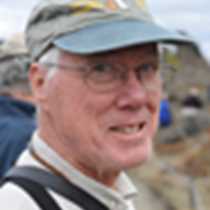North Spitsbergen, Svalbard
The dominant climatic gradient of Svalbard is west (warm) to east (cold), rather than south to north as we might expect. The warm, salty water of the North Atlantic Current, the last gasp of the Gulf Stream, warms the west coast of Spitsbergen, bringing surprisingly temperate (if we can use that term in the High Arctic) conditions far to the north.
In 1596 the Dutch expedition of Willem Barents and Jacob von Heemskirk sailed all the way up the ice-free west coast without sighting land until they reached the northwest corner. There they spotted the “sharp peaks” that gave the island its name. Today we saw evidence of these conditions in the rich plant life of Reindeer Flats in northern Spitsbergen, over 79„a North and only 750 or so statute miles to the North Pole.
In the Arctic, all plant life derives from the shallow, seasonally thawing “active layer” atop the frigid permafrost below, yet tundra plants flower profusely in the short summer season. We walked over tundra vegetation rich in saxifrage species, and carefully stepped around mats of mountain avens, members of the rose family, adorned with flowers of ivory and yellow. We saw the small purple flowers of the moss campion concentrated on the warmer south-facing side of the mat, thus serving as an “arctic compass.”
Evidence of use of the vegetation by reindeer and migratory geese was all around us. Some spotted a small group of Svalbard reindeer far in the distance. They were busily feeding, for they must lay on a thick layer of fat in the summer in order to endure the long, cold, and dark northern winter. The cold and dark will also soon reclaim the lonely grave of a German soldier who perished here while manning a weather station in 1944.
Our ship continued farther into Liefdefjorden to reach Monacobreen, a large glacier named to honor Albert I Grimaldi, Prince of Monaco and a great supporter of oceanographic research in the late 19th and early 20th Centuries. His mapping of the faces of glaciers in his yacht the Princess Alice provides a reference against which to chart glacial retreat over the past 115 or so years.
At Monacobreen we cruised by kayak and Zodiac through recently calved glacial ice. The abundance of ice floating in the fjord is evidence that the glacier is active, and we heard the occasional thunder as tons of ice fell from the glacier face. Where freshwater streams emerge from beneath the glacier we found hordes of kittiwakes feeding on marine organisms that are shocked by the mixing of fresh and salt water. Our cruising was interrupted by three Swedish Vikings who emerged from the fog, not to plunder but to offer welcome cups of hot chocolate served with or without additives.
The continuous daylight of the Arctic summer allowed us to continue our exploration after dinner. Our ship took us to Moffen Island, just above 80„a North. Male walrus gather on this low, atoll-like island where they lie together in walrus heaps, to warm the skin while they complete their annual molt. The island is a sanctuary dedicated to the walrus. Even at the designated distance of 300 meters we could marvel at these pinniped behemoths seen on the beaches through the intermittent fog.
And then we turned our ship toward the north in search of the Arctic pack ice.




